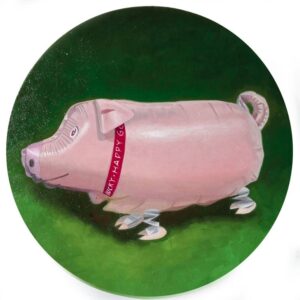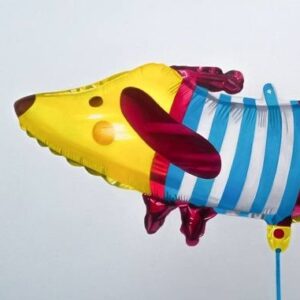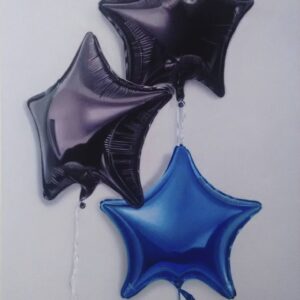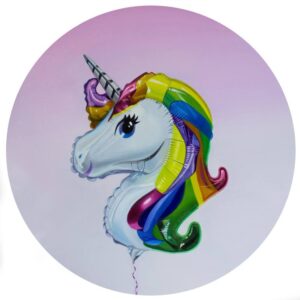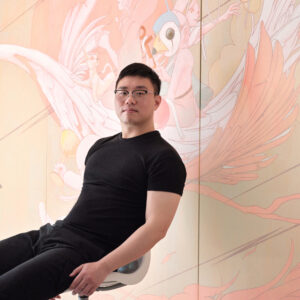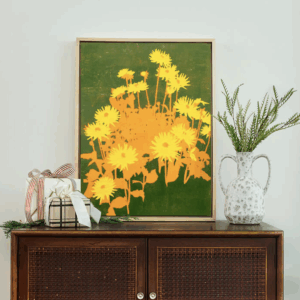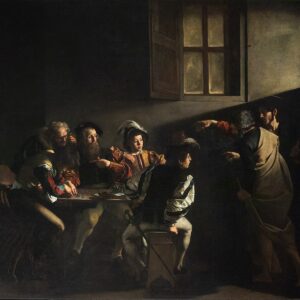One to Watch
 Pop Art Celebrations with Marcela Montemayor
Pop Art Celebrations with Marcela Montemayor
Mexican artist Marcela Montemayor’s cheerfully nostalgic paintings feature brightly colored artifacts of Mexcio’s culture and communities. Her work is held in private collections internationally and has been featured in the Saatchi Art print catalog. Keep reading to learn more about the inspiration behind her joyful artwork.
Tell us about who you are and what you do. What’s your background?
My name is Marcela Montemayor, and I have been a professional painter since 2012. I received my Bachelor’s degree in Visual Arts at the Autonomous University of Nuevo Leon in my hometown, Monterrey, México. At first, I was more interested in drawing, but then, after some classes, I started taking painting more seriously shortly before graduating. For the next few years, I was an art teacher for children. This allowed me to combine my work as a teacher with my own artistic practice.
What does your work aim to say? What are the major themes you pursue in your work?
I made my first ever painting (“Purple Candy Bag,” 2012) because, in Mexico, we have the tradition of giving out candy bags at the end of children’s birthday parties. I had one of the purple candy bags at home and suddenly decided that it would be fun to paint because of its meaning and its vivid colors. I realized I would love to immortalize that joyful moment through the wrappers or the balloons used in the celebrations. That’s what I love to do.
Can you walk us through your process for creating a work from beginning to end?
At first, I look for figures that attract me, such as balloons and wrappers, which capture my attention due to their shapes, colors, and textures. I love exploring different perspectives. Although in most of my paintings the objects are facing the front, I take several photos from different angles. This process allows me to better appreciate the details and decide which of the images will be chosen to take to the canvas. Once I select the winning photo, I begin carefully drawing the lines on the canvas. This is a fundamental step since it establishes the basis of my work.
Next, I start with the underpainting, the first layer of paint that is crucial to visualizing what the finished piece will look like. This first contact with burnt brown and sienna colors helps me define the general atmosphere of the work. After the underpainting dries, I spend a lot of time on the second layer. My paintings rely on details, and I have to paint with very small brushes and be very thorough and careful, meaning a painting may take me several weeks or even months to finish. It is in this second layer where I really have fun. I often choose to exaggerate the colors, seeking to make the painting more lively. I want each stroke to transmit energy, immersing the viewer in the world I have created. Every decision I make during this process is an opportunity to express my artistic vision and bring my ideas to life.
How does your work comment on current social and political issues?
I think art is a way to protect a culture’s identity and values. The objects I paint may seem simple, but they are powerful symbols of everyday life and the traditions that unite us as a society.
In Mexico, for example, the tradition of giving bags of candy at the end of children’s parties is not only a gesture of courtesy but also a manifestation of our culture and a reflection of the values we share. By immortalizing these moments through painting, I am showing a part of our cultural identity. Furthermore, by creating a feeling of familiarity and nostalgia in the viewer, I invite everyone to reflect on their own memories and emotions. This introspection has a transformative power since it connects us with our roots and with the shared experiences that define us as a community. It is in this connection that the essence of politics lies: the search for common ground, mutual understanding, and a future in which our traditions and values are respected and kept alive.
How do you hope viewers respond to your works? What do you want them to feel?
My intention is for viewers of my works to experience a feeling of familiarity and nostalgia that evokes pleasant memories and moments of fun.
Who are your biggest influences, and why?
Andy Warhol, Jeff Koons, and Wayne Thiebaud, especially his food paintings. I really love the playful pastel colors in his works.
If you couldn’t be an artist, what would you do?
If I wasn’t an artist, I would be a pastry chef.
If you could only have one piece of art in your life, what would it be?
Nighthawks by Edward Hopper.
